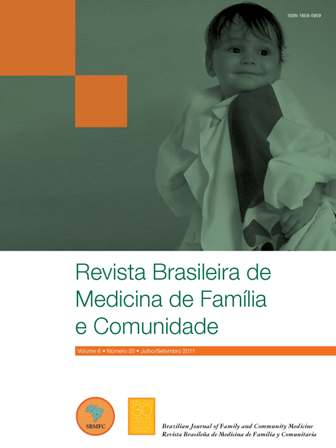Older people’s spatial distribution in the city of Botucatu according to their level of physical activity in recreation and leisure activities
DOI:
https://doi.org/10.5712/rbmfc6(20)251Keywords:
Aged, Motor Activity, Residence CharacteristicsAbstract
Introduction: As the population ages, there is increasing concern about the maintenance of people’s quality of life and functional capacity, which are associated with their level of activity performed. The use of geoprocessing techniques enables the spacial analysis of health data by relating them to the characteristics of the studied population, and this allows for targeting actions at specific risk groups. Objectives: To study the spatial distribution of the populaiton of individuals aged 60 years and over in the city of Botucatu, SP according to their level of physical activity. Methods: Systematic population sampling by families was performed. Of the families comprising elderly members, 365 were randomly selected, corresponding to a prevalence of 50% with a margin of error of 5% and confidence of 95%. Various instruments were applied to the older individuals in order to evaluate quality of life and lifestyle, such as the International Physical Activity Questionnaire (IPAQ). By using the domain of physical activities, sports, recreation and leisure, the older individuals were classified as very active, active, irregularly active and sedentary, according to Matsudo (2001). To evaluate the older people’s spatial distribution based on their level of leisure physical activity, Moran’s index was used. Analyses were performed by the GeoDa software. Results: It was observed that the level of physical activity was low, and that there was association between the sites provided for sports practice, topography and the level of physical activity. No relation was observed between physical activity level and the respondents’ gender or age. Conclusion: Increase and better distribution of the structure for physical activity practice would help improve physical activity at this age range and, therefore, the individuals’ quality of life.
Downloads
Metrics
References
Dias JR, Costa CS, Lacerda MA. O envelhecimento da população brasileira: uma análise de conteúdo das páginas da REBEP. Rev Bras Geriatr Gerontol. 2006 Set; 9(2). DOI: https://doi.org/10.1590/1809-9823.2006.09022
Moraes JLD, Souza, VBA. Factors associated with the successfull aging of the socially-active elderly in the metropolitan region of Porto Alegre. Rev Bras Psiquiatr. 2005 Dez;27(4):302-8. DOI: https://doi.org/10.1590/S1516-44462005000400009
Rosa TEC, Benício MHD, Latorre MRDO e Ramos LR. Fatores determinantes da capacidade funcional entre idosos. Rev Saúde Pública. 2003 Fev;37(1):40-8. DOI: https://doi.org/10.1590/S0034-89102003000100008
Brasil; Ministério da Saúde; Secretaria de Vigilância em Saúde; Secretaria de Atenção à Saúde; Instituto Nacional de Câncer, Coordenação de Prevenção e Vigilância. Inquérito domiciliar sobre comportamentos de risco e morbidade referida de doenças e agravos não transmissíveis: Brasil, 15 capitais e Distrito Federal, 2002-2003. Rio de Janeiro: INCA, 2004.
Organização Pan-Americana da saúde. Doenças crônico-degenerativas e obesidade: estratégia mundial sobre alimentação saudável, atividade física e saúde. Brasília, 2003.
Matsudo SM, Keihan V, Matsudo R e Barros Neto TL. Impacto do envelhecimento nas variáveis antropométricas, neuromotoras e metabólicas da aptidão física. Rev Bras Ciên e Mov. 2000;8(1):15-21.
Associação Médica Brasileira, Conselho Federal de Medicina, Sociedade Brasileira de Medicina do Esporte. Atividade física e saúde. Projeto Diretrizes 2001.
World Health Organization [homepage na internet]. Physical activity and older people. [Acesso em 04 ago 2007]. Disponível em:
http://www.who.int/moveforhealth/advocacy/information_sheets/elderly/en/index.html
Matsudo SM. Atividade física na promoção da saúde e qualidade de vida no envelhecimento. Rev Bras Educ Fís Esp. 2006 Set;20 Supl 5:S135-37.
World Health Organization. Envelhecimento ativo: uma política de saúde / World Health Organization; tradução Suzana Gontijo. Brasília : Organização Pan-Americana da Saúde, 2005.
Bezerra Filho JG, Kerr LRFS, Miná DL, Barreto ML. Distribuição espacial da taxa de mortalidade infantil e principais determinantes no Ceará, Brasil, no período 2000-2002. Cad Saúde Pública. 2007 Mai;23(5):1173-85. DOI: https://doi.org/10.1590/S0102-311X2007000500019
Pina, MFRP. Potencialidades dos Sistemas de Informações Geográficas na Área da Saúde. In: Najar AL & Marques EC. Saúde e Espaço: Estudos metodológicos e técnicas de análise. Rio de Janeiro: Editora Fiocruz, 1998.
Carvalho, MS. Aplicação de métodos de análise espacial na caracterização de áreas de risco a saúde [dissertação de doutorado]. Engenharia Biomédica, COPPE/ UFRJ. Rio de Janeiro, 1997.
Hino P, Santos CB , Villa TCS. Evolução espaço-temporal dos casos de tuberculose em Ribeirão Preto (SP), nos anos de 1998 a 2002. J Bras Pneumol. 2005 Nov/Dez;31(6):523-7. DOI: https://doi.org/10.1590/S1806-37132005000600011
Jóia LC, Ruiz T, Donalisio MR. Condições associadas ao grau de satisfação com a vida entre a população de idosos. Rev Saúde Pública. 2007 Fev;41(1):131-8. DOI: https://doi.org/10.1590/S0034-89102007000100018
Matsudo, SM, Araujo T, Matsudo V, Andrade D, Andrade E, Oliveira LC, Braggion. IPAQ: estudo de validação e reprodutibilidade no Brasil. Rev Bras Ativ Fís Saúde. 2001; 6(2):5-18.
Moran, PAP. Notes on continuous stochastic phenomenon. Biometrika, 1950; 37:17-23. DOI: https://doi.org/10.1093/biomet/37.1-2.17
Anselin, L. GeoDa 0.9 User’s Guide. Spatial Analysis Laboratory (SAL). Department of Agricultural and Consumer Economics, University of Illinois, Urbana-Champaign, IL, 2003.
Marshall, RJ. Mapping disease and mortality rates using Empirical Bayes estimators. Appl Statist. 1991;40(2): 283-94. DOI: https://doi.org/10.2307/2347593
Skaba DA , Carvalho MS, Barcellos C , Martins PC , Terron SL. Geoprocessamento dos dados da saúde: o tratamento dos endereços. Cad Saúde Pública, 2004 Nov/Dez;20(6):1753-6. DOI: https://doi.org/10.1590/S0102-311X2004000600037
Susser, M. The Logic in Ecological: I. The Logic of Analysis. American Journal of Public Health. 1994 Mai;84(5): 825-29. DOI: https://doi.org/10.2105/AJPH.84.5.825
Barcellos, C, Bastos, FI. Geoprocessamento, ambiente e saúde: uma união possível? Cad Saúde Pública. 1996 Jul/Set;12( 3): 389-97. DOI: https://doi.org/10.1590/S0102-311X1996000300012
Downloads
Published
How to Cite
Issue
Section
License
By submitting a manuscript to the RBMFC, authors retain ownership of the copyright in the article, and authorize RBMFC to publish that manuscript under the Creative Commons Attribution 4.0 license and identify itself as the vehicle of its original publication.















